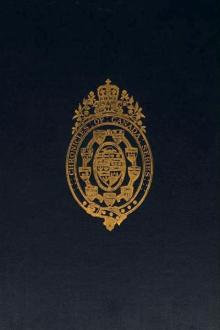The Dawn of Canadian History, Stephen Leacock [best pdf ebook reader .txt] 📗

- Author: Stephen Leacock
- Performer: -
Book online «The Dawn of Canadian History, Stephen Leacock [best pdf ebook reader .txt] 📗». Author Stephen Leacock
It is needless, however, to prove that the Norsemen could have reached America in their ships. The voyages from Iceland to Greenland which we know they made continually for four hundred years were just as arduous as a further voyage from Greenland to the coast of Canada.
The story of the Norsemen runs thus. Towards the end of the ninth century, or nearly two hundred years before the Norman conquest, there was a great exodus or outswarming of the Norsemen from their original home in Norway. A certain King Harold had succeeded in making himself supreme in Norway, and great numbers of the lesser chiefs or jarls preferred to seek new homes across the seas rather than submit to his rule. So they embarked with their seafaring followers—Vikings, as we still call them—often, indeed, with their wives and families, in great open ships, and sailed away, some to the coast of England, others to France, and others even to the Mediterranean, where they took service under the Byzantine emperors. But still others, loving the cold rough seas of the north, struck westward across the North Sea and beyond the coasts of Scotland till they reached Iceland. This was in the year 874. Here they made a settlement that presently grew to a population of fifty thousand people, having flocks and herds, solid houses of stone, and a fine trade in fish and oil with the countries of Northern Europe. These settlers in Iceland attained to a high standard of civilization. They had many books, and were fond of tales and stories, as are all these northern peoples who spend long winter evenings round the fireside. Some of the sagas, or stories, which they told were true accounts of the voyages and adventures of their forefathers; others were fanciful stories, like our modern romances, created by the imagination; others, again, were a mixture of the two. Thus it is sometimes hard to distinguish fact and fancy in these early tales of the Norsemen. We have, however, means of testing the stories. Among the books written in Iceland there was one called the 'National Name-Book,' in which all the names of the people were written down, with an account of their forefathers and of any notable things which they had done.
It is from this book and from the old sagas that we learn how the Norsemen came to the coast of America. It seems that about 900 a certain man called Gunnbjorn was driven westward in a great storm and thrown on the rocky shore of an ice-bound country, where he spent the winter. Gunnbjorn reached home safely, and never tried again to find this new land; but, long after his death, the story that there was land farther west still lingered among the settlers in Iceland and the Orkneys, and in other homes of the Norsemen. Some time after Gunnbjorn's voyage it happened that a very bold and determined man called Eric the Red, who lived in the Orkneys, was made an outlaw for having killed several men in a quarrel. Eric fled westward over the seas about the year 980, and he came to a new country with great rocky bays and fjords as in Norway. There were no trees, but the slopes of the hillsides were bright with grass, so he called the country Greenland, as it is called to this day. Eric and his men lived in Greenland for three years, and the ruins of their rough stone houses are still to be seen, hard by one of the little Danish settlements of to-day. When Eric and his followers went back to Iceland they told of what they had seen, and soon he led a new expedition to Greenland. The adventurers went in twenty-five ships; more than half were lost on the way, but eleven ships landed safely and founded a colony in Greenland. Other settlers came, and this Greenland colony had at one time a population of about two thousand people. Its inhabitants embraced Christianity when their kinsfolk in other places did so, and the ruins of their stone churches still exist. The settlers raised cattle and sheep, and sent ox hides and seal skins and walrus ivory to Europe in trade for supplies. But as there was no timber in Greenland they could not build ships, and thus their communication with the outside world was more or less precarious. In spite of this, the colony lasted for about four hundred years. It seems to have come to an end at about the beginning of the fifteenth century. The scanty records of its history can be traced no later than the year 1409. What happened to terminate its existence is not known. Some writers, misled by the name 'Greenland,' have thought that there must have been a change of climate by which the country lost its original warmth and verdure and turned into an arctic region. There is no ground for this belief. The name 'Greenland' did not imply a country of trees and luxuriant vegetation, but only referred to the bright carpet of grass still seen in the short Greenland summer in the warmer hollows of the hillsides. It may have been that the settlement, never strong in numbers, was overwhelmed by the Eskimos, who are known to have often attacked the colony: very likely, too, it suffered from the great plague, the Black Death, that swept over all Europe in the fourteenth century. Whatever the cause, the colony came to an end, and centuries elapsed before Greenland was again known to Europe.
This whole story of the Greenland settlement is historical fact which cannot be doubted. Partly by accident and partly by design, the Norsemen had been carried from Norway to the Orkneys and the Hebrides and Iceland, and from there to Greenland. This having happened, it was natural that their ships should go beyond Greenland itself. During the four hundred years in which the Norse ships went from Europe to Greenland, their navigators had neither chart nor compass, and they sailed huge open boats, carrying only a great square sail. It is evident that in stress of weather and in fog they must again and again have been driven past the foot of Greenland, and must have landed somewhere in what is now Labrador. It would be inconceivable that in four centuries of voyages this never happened. In most cases, no doubt, the storm-tossed and battered ships, like the fourteen vessels that Eric lost, were never heard of again. But in other cases survivors must have returned to Greenland or Iceland to tell of what they had seen.
This is exactly what happened to a bold sailor called Bjarne, the son of Herjulf, a few years after the Greenland colony was founded. In 986 he put out from Iceland to join his father, who was in Greenland, the purpose being that, after the good old Norse custom, they might drink their Christmas ale together. Neither Bjarne nor his men had ever sailed the Greenland sea before, but, like bold mariners, they relied upon their seafaring instinct to guide them to its coast. As Bjarne's ship was driven westward, great mists fell upon the face of the waters. There was neither sun nor stars, but day after day only the thick wet fog that clung to the cold surface of the heaving sea. To-day travellers even on a palatial steamship, who spend a few hours shuddering in the chill grey fog of the North Atlantic, chafing at delay, may form some idea of voyages such as that of Bjarne Herjulf and his men. These Vikings went on undaunted towards the west. At last, after many days, they saw land, but when they drew near they saw that it was not a rugged treeless region, such as they knew Greenland to be, but a country covered with forests, a country of low coasts rising inland to small hills, and with no mountains in sight. Accordingly, Bjarne said that this was not Greenland, and he would not stop, but turned the vessel to the north. After two days they sighted land again, still on the left side, and again it was flat and thick with trees. The sea had fallen calm, and Bjarne's men desired to land and see this new country, and take wood and water into the ship. But Bjarne would not. So they held on their course, and presently a wind from the south-west carried them onward for three days and three nights. Then again they saw land, but this time it was high and mountainous, with great shining caps of snow. And again Bjarne said, 'This is not the land I seek.' They did not go ashore, but sailing close to the coast they presently found that the land was an island. When they stood out to sea again, the south wind rose to a gale that swept them towards the north, with sail reefed down and with their ship leaping through the foaming surges. Three days and nights they ran before the gale. On the fourth day land rose before them, and this time it was Greenland. There Bjarne found his father, and there, when not at sea, he settled for the rest of his days.
Such is the story of Bjarne Herjulf, as the Norsemen have it. To the unprejudiced mind there is every reason to believe that his voyage had carried him to America, to the coast of the Maritime Provinces, or of Newfoundland or Labrador. More than this one cannot say. True, it is hard to fit the 'two days' and the 'three days' of Bjarne's narrative into the sailing distances. But every one who has read any primitive literature, or even the Homeric poems, will remember how easily times and distances and numbers that are not exactly known are expressed in loose phrases not to be taken as literal.
The news of Bjarne's voyage and of his discovery of land seems to have been carried presently to the Norsemen in Iceland and in Europe. In fact, Bjarne himself made a voyage to Norway, and, on account of what he had done, figured there as a person of some importance. But people blamed Bjarne because he had not landed on the new coasts, and had taken so little pains to find out more about the region of hills and forests which lay to the south and west of Greenland. Naturally others were tempted to follow the matter further. Among these was Leif, son of Eric the Red. Leif went to Greenland, found Bjarne, bought his ship, and manned it with a crew of thirty-five. Leif's father, Eric, now lived in Greenland, and Leif asked him to take command of the expedition. He thought, the saga says, that, since Eric had found Greenland, he would bring good luck to the new venture. For the time, Eric consented, but when all was ready, and he was riding down to the shore to embark, his horse stumbled and he fell from the saddle and hurt his foot. Eric took this as an omen of evil, and would not go; but Leif and his crew of thirty-five set sail towards the south-west. This was in the year 1000 A.D., or four hundred and ninety-two years before Columbus landed in the West Indies.
Leif and his men sailed on, the saga tells us, till they came to the last land which Bjarne had discovered. Here they cast anchor, lowered a boat, and





Comments (0)